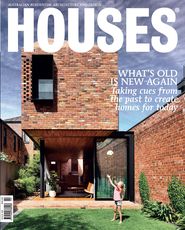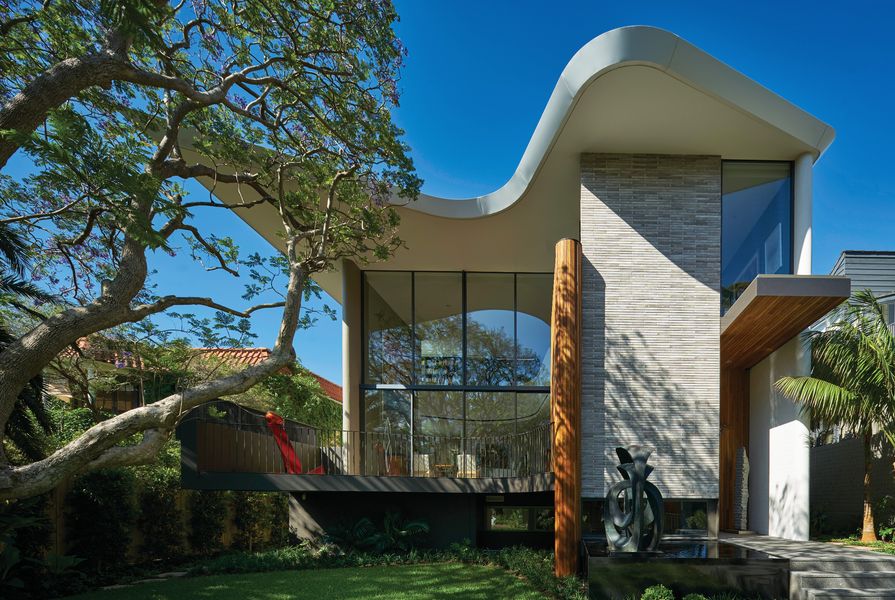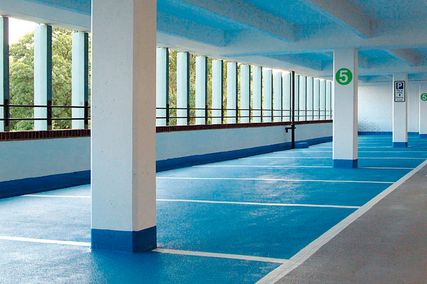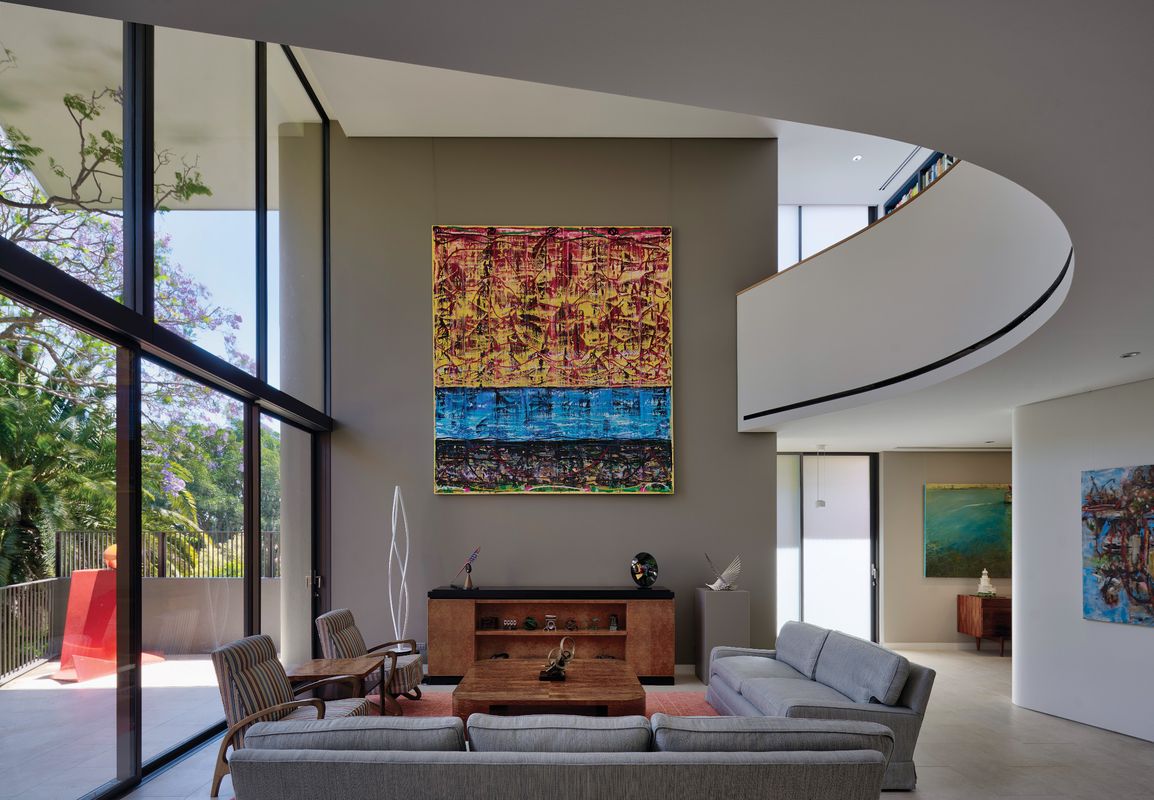When looking at architecture it is easy to forget the complex problem-solving that is at its heart. Facades, finishes and furnishings capture our eyes, and yet behind these elements are weeks and months of communication, negotiation, planning, testing and correction. The Bellevue Hill House IV by Popov Bass presents to the world a tailored and sophisticated face – as would be expected. However, its genesis tackled the very real and increasingly relevant issue of how to design a home that allows for its owners to continue living in and enjoying it as they age. Add to the mix an extensive art collection, two large protected trees and a sloping site, and you have complex problem-solving at its best.
The organic, curved geometry of the double-height void mirrors the distinctive expression of the house’s roof. Artwork (L-R): Michael Johnson; Peter Kingston; Ann Thomson.
Image: Michael Nicholson
Located in Sydney’s Bellevue Hill, the house occupies a sloping site and the design took many of its cues from the previous structure, particularly in relation to the levels. The organizing principle of the scheme refers to two key aspects that determined the planning and the architectural expression: mobility access (both horizontal and vertical) and the dialogue between the house and the two existing mature jacaranda trees, one at the front of the house and one at the rear. The brief required that all levels and all rooms of the house be designed to allow for full mobility access. While this is not currently an issue for the clients, they had a clear aim to “remain in this house for as long as possible.” Each level of the house is zoned programmatically, with the car access and entrance on the lower ground level, guest quarters on the garden level, formal entry and living spaces on the rear garden level and study/sleeping spaces on the upper. The thresholds between inside and outside spaces are on grade, and door widths and bathrooms are designed to accommodate future mobility aids. Independent carer’s quarters have also been included in the design so that if this need eventuates, the facilities are already there.
The mezzanine is bound by a study and library with direct visual connection to the garden and jacaranda tree. Artwork (L-R): Michael Johnson; Michael Johnson; Sonia Delaunay; Aida Tomescu (lower level).
Image: Michael Nicholson
The horizontal compartmentalization of the design and the inclusion of a lift meant that the use of a grand staircase as a major tectonic/spatial device was redundant. To avoid the risk of a stacked plan, Popov Bass included a double-height void in the formal living room. The curved geometry of this void was generated from the position of the jacaranda tree at the front. The geometry marks and carves its way through the cubic form of the body of the house. A wishbone structure separates the formal spaces at the front from the informal spaces at the rear. Brian Bass, director at Popov Bass, states that the spatial configuration of the interior was designed to “zone but not isolate.” The client agrees, saying that one of the things she loves most about this house is that she “can see every-thing from everywhere.”
Another key aspect of the brief was the accommodation of the clients’ extensive art collection. Large areas of vertical wall space were required to hang the many paintings of varying sizes. One of the most impressive spaces is the entry gallery on the lower ground level. This space connects the garage on the property boundary with the lift in the centre of the house. Brian says it was imperative that this space did not end up a long, dark corridor. Instead, the architects have created a space that really feels like an art gallery, well proportioned and well lit. The house is undeniably large, but there is no loss of intimacy in the spaces. The clients say that they never feel like they are “floundering around” and the visual connection between the spaces mitigates the feeling of being overwhelmed or lost. Large volumes are contrasted by smaller-scaled spaces, such as the study near the kitchen or the library above the void. Compensating for the large scale of the project, the house excels in its sustainability credentials, with double the minimum mandatory requirements for BASIX (Building Sustainability Index), high-volume rainwater harvesting, and photovoltaic and hydronic solar systems among its many features.
Informal living spaces open out into the back garden, with an on-grade threshold ensuring easy mobility in the future.
Image: Michael Nicholson
Brian sees the Bellevue Hill House IV as part of the “next generation of projects” to come out of the office. While the house has the Popov Bass hallmark features of spatial sequencing, play of natural light and the use of double-height spaces, this project is “freer in form,” particularly in the multiple curves that mark the roof lines and the internal voids. And to the delight of the client, the home is comfortable to live in – something that Popov Bass aims to achieve in all its residential work.
Products and materials
- External walls
- Worldstone Masonry and Services masonry; Murobond mineral silicate paint, with sand; Woodform Architectural expression cladding; Symonite aluminium cladding.
- Internal walls
- Plasterboard painted in Dulux and Porter’s paints.
- Windows
- Fairview windows from Award Architectural Aluminium.
- Doors
- Frits Jurgens hinges and Olivari and Elmes door handles, all from Bellevue Architectural.
- Flooring
- Di Lorenzo porcelain floor tiles; Delsa ceramic floor tiles.
- Lighting
- Erco lights; Flos lights from Euroluce; Darkon lights.
- Kitchen
- Siemens cooktop; Gaggenau ovens; Fisher and Paykel dishwasher and fridge; Blanco basin and tap set; Zip Hydrotap.
- Bathroom
- Brodware tapware; Duravit basin and toilet; Kaldewei bath; wall tiles from Artedomus.
- Heating and cooling
- Comfort Heat hydronic heating; central airconditioning.
- External elements
- Aalta louvres and awning; Graham Day garage door; Australian Turntable Company turntable; metalwork by North Shore Fabrication.
- Other
- Metal finishes by Astor Metal Finishes; special metal fabrication by JN Custom Metal; Easy Living Home Elevators lift; Art Hanging Systems system.
Credits
- Project
- Bellevue Hill House IV
- Architect
- Popov Bass Architects
Milsons Point, Sydney, NSW, Australia
- Project Team
- Farnam Ghazizadeh, Brian Bass, Paul Brace, Allison Hair, Anthony Zonaga, Alex Popov
- Consultants
-
Builder
GNC Quality
Colour consultant Virginia Carroll
Engineer D’Ambrosio Consulting
Hydraulic engineer AJ Whipps Consulting Group
Joinery Sydney Joinery
Landscaping Myles Baldwin Design
Services Cundall Australia
- Site Details
-
Location
Sydney,
NSW,
Australia
Site type Suburban
Site area 860 m2
Building area 500 m2
- Project Details
-
Status
Built
Completion date 2017
Construction 24 months
Category Residential
Type New houses
Source

Project
Published online: 1 Aug 2018
Words:
Sing d'Arcy
Images:
Michael Nicholson
Issue
Houses, April 2018
























